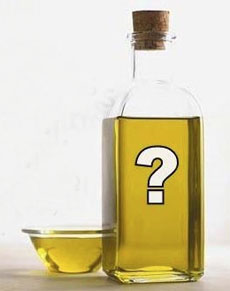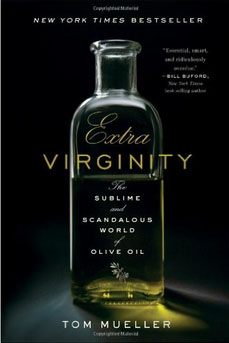TIP OF THE DAY: Beware Of Fake Italian Olive Oil
 The odds are high that your bottle of imported “extra virgin in olive oil” isn’t extra virgin or even pure olive oil, especially if it’s a major supermarket brand and/or sold in bulk. Photo courtesy LiveFreeLiveNatural.com. |
“Is this for real?” a reader wrote, sending us a link to an article about fake olive oil. While we’ve covered this topic previously and also here, it’s worth revisiting. There’s a lot of fake imported oil claiming to be Italian olive oil. In fact, fake olive oil has been a major scandal in Italy for decades. People have gone to jail for oil fraud, although that doesn’t stop the practice. Unscrupulous Italian distributors import oil from Morocco, Spain (the largest producer of olive oil), Tunisia or elsewhere; bottle it in Italy and sell it a Italian olive oil. Sometimes, it’s a blend of a lower-quality Italian oil cut with non-Italian olive oil. Or it can be another oil entirely, such as soybean oil labeled “olive oil” on the manifest. Totally fake olive oil can be made by mixing cheap vegetable oils with beta-carotene to disguise the flavor, and chlorophyll to provide the green color many people believe (erroneously) indicates higher-quality olive oil. If the olive oil is bottled in Italy, it is not illegal to label it “Packed in Italy” or “Imported from Italy,” terms that easily deceive consumers. While a different country of origin is supposed to be listed on the label, often it is not. Italy is, in fact, the world’s largest importer of olive oil. Much of the oil sold as “Italian olive oil” isn’t, based on tests conducted in the U.S. |
|
|
A special branch of the Italian police is trained to detect bad oil; but as in most inspections of most product categories in any country, there are too many products and too few inspectors. Even when fraud is found, producers—many of whom have connections to powerful politicians—are rarely prosecuted. [Source] Just because the label says “extra-virgin olive oil” does not mean that’s what’s in the bottle. In fact, it may not even be 100% olive oil. It can be a blend of lower-quality vegetable oils that may include less than 20% olive oil. The “extra virgin” label has strict IOC (International Olive Council) requirements; namely, that the acidity of the oil is less than 1%. If the acidity is between 1% and 3.3%, the oil is called virgin olive oil; and the higher the acidity, the lower the grade of oil (here are the grades of olive oil). Much olive oil sold as “extra virgin” isn’t. A 2010 study by U.C. Davis, one of America’s top agricultural universities, found that 69% of the imported “extra virgin” olive oil sold in California supermarkets did not qualify as extra virgin (the results can be extrapolated to the rest of the country). That means your chance of buying real extra virgin is less than 1 in 3. Here’s the full report. The Executive Summary begins: While there are many excellent imported and domestic extra virgin olive oils available in California, our findings indicate that the quality level of the largest imported brand names is inconsistent at best, and that most of the top-selling olive oil brands we examined regularly failed to meet international standards for extra virgin olive oil. Of the five top-selling imported “extra virgin” olive oil brands in the United States, 73% of the samples failed the IOC sensory standards for extra virgin olive oils, analyzed by two separate IOC-accredited sensory [tasting] panels. The fraud typically comes from supermarket brands, store brands and club store brands that sell in big volume. There is nothing harmful about the olive oil, but it isn’t of the quality of the Italian olive oil you think you’re paying for. If you’re buying it for it’s heart-healthy benefits, you may not be getting them. In 2010, a class action lawsuit in California targeted 10 major olive oil brands: Bertolli, Carapelli, Colavita, Filippo Berio, Mazola, Mezzetta, Pompeian, Rachael Ray, Safeway Select and Star. It also names 10 major supermarket chains and big box stores that allegedly sold substandard oil as “extra-virgin.” This includes olive oil mixed with cheaper types of oil, lower quality olive oil and olive oil degraded by heat or age. Artisan oils from smaller brands are typically what they claim to be. They don’t sell in enough volume to interest the fraudsters. |
||
|
GREEN COLOR DOESN’T MEAN BETTER OLIVE OIL
Consumers have come to believe that green olive oil is better quality. So another trick fraudsters use is to color yellow olive oil green with chlorophyll. While some green oils are top quality, the color of the oil is determined by: |
 What started out as an exposé in The New York Times is now an even more informative book. Photo courtesy W. W. Norton & Company. |
|
|
|
||


